209. The Head of Ku was
close to the Full Moon at
the beginning of side b on the C tablet:
|
BABYLONIAN ECLIPTIC
CONSTELLATIONS: |
|
26 |
Mahar sha hi-na Shahū |
Western One in the Tail of
the Goat |
γ (Nashira)
Capricorni |
328.0 |
Febr 12 (43) |
|
27 |
Arkat sha hi-na Shahū |
Eastern One in the Tail of
the Goat |
δ (Deneb Algiedi)
Capricorni |
329.8 |
Febr 13 (44) |
|
|
|
0 |
1-iku |
Field measure |
τ
(Anunitum)
Piscium |
16.5 |
April 6 (96) |
|
|
|
1 |
Mahrū-sha-rishu-ku |
Front of the Head of Ku |
β (Sheratan),
γ (Mesarthim) Arietis |
27.4 |
April 17 (107) |
|
2 |
Arku-sha-rishu-ku |
Back of the Head of Ku |
α (Hamal)
Arietis |
30.5 |
April 20 (110) |
 |
 |
 |
 |
 |
 |
 |
|
*Ca14-29 (392) |
Cb1-1 |
Cb1-2 |
Cb1-3 |
Cb1-4 (396) |
Cb1-5 |
Cb1-6 |
|
*209 + *366 |
*576 |
*577 |
*578 |
*579 |
*580 (= 20 * 29) |
*581 |
|
*575 - *366 |
*210 = (420 / 2) |
*211 |
*212 |
*213 (= 396 - 183) |
*214
(= 2 * 107) |
*215 |
|
INVISIBLY CLOSE TO THE SUN
(helical dates): |
|
no star listed (189 + 386 - 366
= 209) |
MUPHRID
(Solitary Star) = η Bootis
(210.1), ζ Centauri (210.3) |
φ Centauri (211.0), υ¹ Centauri
(211.1), υ² Centauri (211.8), τ
Virginis (211.9) |
AGENA (At the Knee) = β Centauri
(212.1), θ Apodis (212.5),
THUBAN (Dragon) = α Draconis
(212.8) |
14h (213.1)
π Hydrae,
χ Centauri (213.0),
MENKENT
(Shoulder of the Centaur) = θ
Centauri
(213.1) |
Neck-2 (Dragon)
ASELLUS TERTIUS (3rd Ass Colt) =
κ Bootis,
κ Virginis,
14 Bootis
(214.8) |
Al Ghafr-13 (The Cover) /
Svāti-15 (Very Good) /
TAHUA-TAATA-METUA-TE-TUPU-MAVAE-6
(a pillar to stand by)
15 Bootis
(215.2),
ARCTURUS = α
Bootis
(215.4),
ASELLUS
SECUNDUS (2nd Ass Colt) =
ι Bootis
(215.5),
SYRMA (Train of the Virgin's
Robe) = ι Virginis,
λ Bootis (215.6), η Apodis
(215.8) |
|
16 |
April 17 (107) |
18 |
19 |
20 |
21 |
22 (112) |
|
CLOSE TO THE FULL MOON (and
nakshatra dates): |
|
Oct 16 |
(290 = 107 + 183) |
18 |
19 |
20 |
21 |
22 (295) |
|
ANA-NIA-10
(Pillar-to-fish by)
χ
Ceti (26.1),
POLARIS = α Ursae Minoris,
BATEN KAITOS = ζ Ceti
(26.6),
METALLAH = α Trianguli
(26.9) |
Al Sharatain-1 /
Ashvini-1 /
Bond-16 (Dog) /
Mahrū-sha-rishu-ku-1
(Front of the Head of Ku)
SEGIN = ε
Cassiopeia, MESARTHIM = γ
Arietis, ψ Phoenicis
(27.2),
SHERATAN (Pair of Signs) = β
Arietis,
φ Phoenicis (27.4) |
ι
Arietis (28.0), λ Arietis
(28.2), υ Ceti (28.8) |
ALRISHA (The Knot) = α Piscium,
χ Phoenicis (29.2),
ALAMAK
(Caracal) = γ Andromedae
(29.7) |
Arku-sha-rishu-ku-2 (Back of
the Head of Ku)
2h (30.4)
κ
Arietis (30.3),
HAMAL (Sheep) = α Arietis
(30.5)
ALKES (α Crateris)
|
η
Arietis (31.9) |
ξ¹ Ceti (32.1) |
|
209 + 183 |
393 |
394 |
395 |
214 + 182 |
397 |
398 |

 |
 |
 |
 |
 |
|
Cb1-7 |
Cb1-8 (400) |
Cb1-9 |
Cb1-10 |
Cb1-11 |
|
*216 + *366 |
*583 |
*584 |
*585 |
*586 |
|
*216 |
*217 |
*218 |
*219 |
*220 |
|
ι Lupi,
18
Bootis
(216.3),
KHAMBALIA (Crooked-Clawed)
= λ Virginis
(216.4), υ Virginis (216.5),
ψ Centauri (216.6), ε Apodis
(216.8) |
ASELLUS PRIMUS (1st Ass
Colt) = θ Bootis
(217.8) |
τ Lupi, δ Oct. (218.1), φ
Virginis (218.7)
FOMALHAUT (α Piscis
Austrini)
|
σ Lupi (219.1), ρ Bootis
(219.5),
HARIS
(Keeper) = γ Bootis
(219.7) |
σ Bootis (220.2), η Centauri
(220.4) |
|
April 23 |
24 |
25 (115) |
26 |
27 |
|
Synodic
cycles |
|
Mercury |
115.88 |
|
Venus |
583.92 |
|
|
|
Mars |
779.96 |
|
Jupiter |
398.88 |
|
Saturn |
378.09 |
|
Uranus |
369.66 |
 |
|
CLOSE TO THE FULL MOON (and
nakshatra dates): |
|
296 = 80 + *216 |
297 |
*584 - *183 = *401 |
299 |
300 |
|
399 |
400 |
401 |
402 |
403 |
|
χ Persei (33.2), θ Arietis
(33.3),
MIRA = ο Ceti
(33.7) |
no star listed (34) |
ξ Arietis (35.0), ρ Ceti
(35.4), ξ² Ceti (35.9) |
σ Ceti (36.9) |
ν Ceti (37.9) |
|
Oct 23 |
24 |
25 |
26 |
27 (300) |
|
ºOct 19 |
20 |
21 |
22 |
23 (296) |
|
'Sept 26 |
27 |
28 |
29 |
30 (300 - 27) |
|
"Sept 12 |
13 |
14 |
15 |
16 (300 - 41) |
|
AUG 20 |
21 |
22 |
23 |
24 (300 - 64) |
 |
But the young coconut (niu)
growth occurred 16 days after
Polaris (*26), at the place where anciently
Kochab (the Star) had been (*225 - *26 =
*199 = *183 + *16). Here the complications
were beginning:
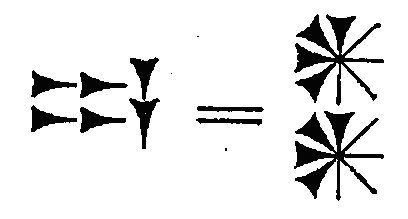
 |
 |
 |
 |
|
Cb1-12 (354 + 50) |
Cb1-13 |
Cb1-14 (350 + 8 * 7) |
Cb1-15 (407) |
|
manu rere - kua rere
ga manu - ki te ragi |
eaha te nuku erua |
koia kua huki |
e niu tu |
|
INVISIBLY CLOSE TO THE
SUN (helical dates): |
|
ρ Lupi (221.0),
TOLIMAN
(Shoot of the Grapevine)
= α Centauri
(221.2), π Bootis
(221.8), ζ Bootis
(221.9) |
31 Bootis (222.0),
YANG MUN
(South Gate) = α Lupi
(222.1),
RIJL AL AWWA (Foot of
the Barker) = μ Virginis
(222.5), ο Bootis
(222.9) |
IZAR
(Girdle) = ε Bootis
(223.0),
109 Virginis,
α
Apodis (No Feet)
(223.3), μ Librae
(223.8) |
Al Zubānā-14a
(Claws)
/
Visakha-16 (Forked) /
Root-3 (Badger)
ZUBEN ELGENUBI
(Southern
Claw)
= α Librae
(224.2), ξ Bootis, ο
Lupi (224.5) |
KOCHAB
(Kakkab,
the Star) = β Ursae Min.
(225.0), ξ Librae
(225.7) |
|
Oct 28 (301) |
29 |
30 (366 - 63) |
31 (304 = 80 + *225) |
Nov 1 |
|
ºOct 24 |
25 |
26 |
27 (300) |
28 |
|
'Oct 1 |
2 |
3 |
4
(277) |
5 |
|
17 (260) |
(*222 - *41) |
"Sept 19 (*182) |
20 |
21 (264) |
|
AUG 25 |
26 (*222 - *64) |
27 (239 = 303 - 64) |
28 (60 + 180) |
29 (241 = 58 + 183) |
|
217 - 218 |
219 |
220 (= 240 - 20) |
221 |
 |
|
CLOSE TO THE FULL MOON
(and nakshatra dates): |
 |
|
ν Arietis (38.5), δ, ε
Ceti (38.8) |
μ Arietis (39.4),
HEAD OF THE FLY
= 35 Arietis
(39.6),
KAFFALJIDHMA (Part of a
Hand) = γ Ceti,
θ Persei (39.8) |
π Ceti, ο Arietis
(40.0),
ANGETENAR
(Bend in the River) = τ¹
Eridani,
μ Ceti (40.2),
RIGHT WING
= 39 Arietis
(40.9) |
Bharani-2 (Yoni) /
Stomach-17 (Pheasant)
π Arietis (41.2),
MIRAM (Next to the
Pleiades) = η Persei
(41.3),
BHARANI
= 41 Arietis (41.4),
τ² Eridani, σ Arietis
(41.7) |
TA LING (Great Mound)
= τ Persei (42.4) |
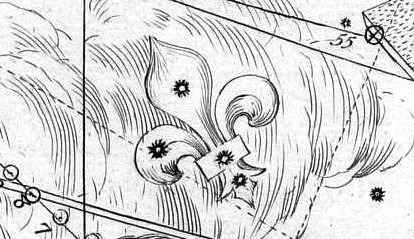
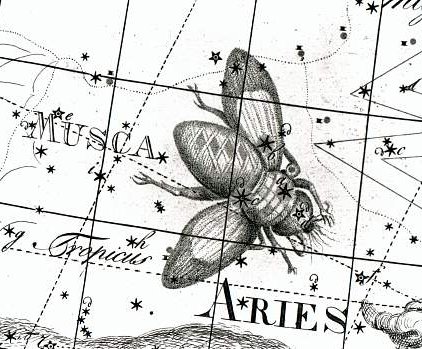 |
|
28 (118) |
(4 * 29½ + 1) |
April 30 |
May 1 (121) |
2 |
|
24 |
25 |
ºApril 26 |
27 |
28 (118) |
|
'April 1 (91) |
2 (7 * 13 + 1) |
3 |
4
(*14 = *41 - *27) |
5 |
|
"March 18 |
19 (*364) |
3-20 (*365) |
0h (*366) |
"March 22 (*1) |
|
FEBR 23 |
BIS-SEXTUM |
25
(56 = 120 - 64) |
26 (*343 = *366 - 23) |
2-27 |
|
34 - 35 |
36 |
37 = 41 - 4 |
38 = 58 - 20 |
|
399 - 400 (= 35 +
365) |
401 |
402 |
403 = 407 - 4 |
|
The sequence of heliacal
star dates in the text
seems here to make a
jump ahead with 1 place,
because *366 = 365 + 1
and from Arcturus, Syrma
(*215) to Zuben Elgenubi
(*224) there were not 9
but 8 glyphs. Likewise
were there 9
precessional days from
*32 to *41 (Bharani).
The sky dome was moving
said Metoro where the
Full Moon reached Mira.
Maeva.
T. 1.
Move. Rangi-maeva
= Moving Sky (name of a
marae). 2. Greet,
greeting. Henry. |
|
...
The leap
day was introduced as
part of the Julian
reform. The day
following the Terminalia
(February 23) was
doubled, forming the 'bis
sextum - literally
'double sixth', since
February 24 was 'the
sixth day before the
Kalends of March' using
Roman inclusive counting
(March 1 was the 'first
day'). Although
exceptions exist, the
first day of the bis
sextum (February 24)
was usually regarded as
the intercalated or
'bissextile' day since
the third century.
February 29 came to be
regarded as the leap day
when the Roman system of
numbering days was
replaced by sequential
numbering in the late
Middle Ages ...
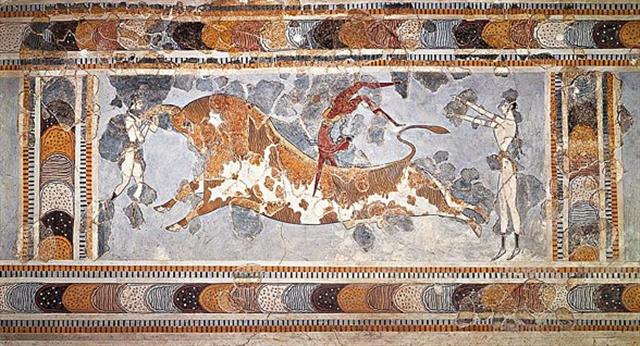 |
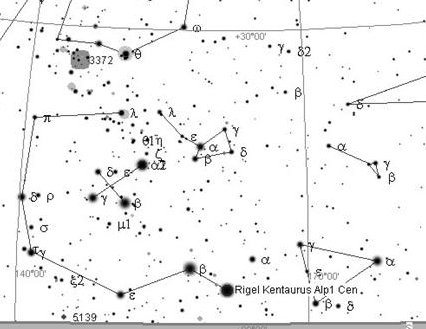
At the time of
Betelgeuze (*88) the Foot of the
Centaur (Rigel Centaurus,
Toliman, *221) would have
(according to a simple
extrapolation) risen heliacally
in day 80 + (221 - 88) = 213 (1
August) and this was 8 days
after Menkent (θ,
*213) - which at the time of
rongorongo was positioned at 14h
(213.1) with Hamal at the other
side of the sky.
... The form of
the letter
θ suggests a midline ('waist'),
although the origin of θ is the
Phoenician tēth which
means 'wheel'. This in turn
could have originated from a
glyph named 'good' which in
Egypt was nfr
...
... There were 10 Star Kings
before the Deluge and the first
one of them was Hamal (α
Arieti s):
... Strassmeier and Epping, in
their Astronomishes aus
Babylon, say that there its
stars formed the third of the
twenty-eight ecliptic
constellations, -
Arku-sha-rishu-ku,
literally the Back of the Head
of Ku, - which had been
established along that great
circle milleniums before our
era; and Lenormant quotes, as an
individual title from cuneiform
inscriptions, Dil-kar,
the Proclaimer of Dawn, that
Jensen reads As-kar, and
others Dil-gan, the
Messenger of Light.
George Smith inferred from the
tablets that it might be the
Star of the Flocks; while
other Euphratean names have been
Lu-lim, or
Lu-nit, the Ram's Eye; and
Si-mal or Si-mul,
the Horn star, which came down
even to late astrology as the
Ram's Horn.
It also was Anuv, and had
its constellation's titles
I-ku and I-ku-u, - by
abbreviation Ku, - the
Prince, or the Leading One, the
Ram that led the heavenly flock,
some of íts titles at a
different date being applied to
Capella of Auriga.
Brown associates it with Aloros,
the first of the ten mythical
kings of Akkad anterior to the
Deluge, the duration of whose
reigns proportionately coincided
with the distances apart of the
ten chief ecliptic stars
beginning with Hamal, and he
deduces from this kingly title
the Assyrian Ailuv, and
hence the Hebrew Ayil;
the other stars corresponding to
the other mythical kings being
Alcyone, Aldebaran, Pollux,
Regulus, Spica, Antares,
Algenib, Deneb Algedi, and
Scheat
...
At the time of Bharani (*41)
Toliman (*221) would have risen
heliacally in day 260
("September 17) which was 180 (=
360 / 2) days later - although
Zuben Elgenubi (*224) arrived 183 (=
366 /2) right ascension days
later.
"Alpha's splendor [-0.01]
naturally made it [Toliman] an
object of worship on the Nile,
and its first visible emergence
from the sun's rays, in the
morning at the autumnal equinox,
has been connected by Lockyer
with the orientation of at least
nine temples in northern Egypt
dating from 3800 to 2575 B.C.,
and of several in southern Egypt
from 3700 B.C. onward. As such
an object of worship it seems to
have been known as
Serk-t ..." (Allen)
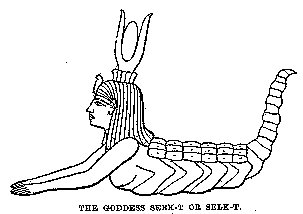
|





















